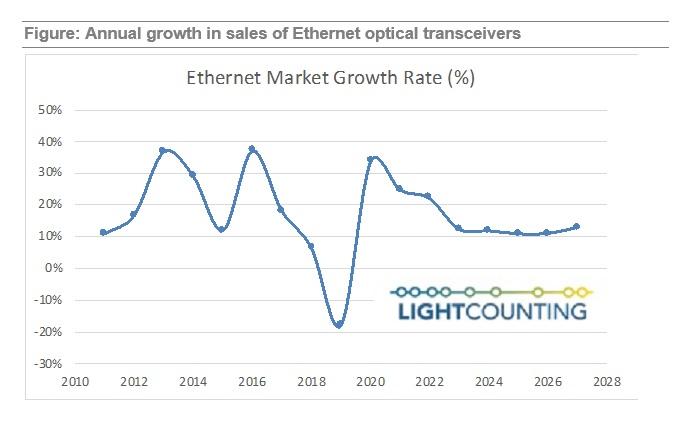Sales of Ethernet optical transceivers set a new record in 2021, reaching $4.6 billion – up 25% from 2020, when the market jumped by 32% after a decline of 18% in 2019, as illustrated in the figure below. LightCounting expects that the growth rate will moderate to a 14% CAGR from 2022 to 2027, but even at this modest growth, the market will reach $10 billion by the end of the forecast period. The market will remain volatile, but our long-term forecast model is not designed to predict the fluctuations but offer a reasonable 5-year target for the industry.

What is driving the growth?
Let’s start from early 2020. Suppliers of optics recovered within a few months from the disruptions caused by Covid-19 early in 2020, and demand for all products ranging from 1 GbE to 400 GbE exceeded expectations for the full year. The rising tide lifted all boats: even sales of 1 GbE transceivers picked up, not to mention 10G and 40G products. Demand for legacy products started to decline at the end of 2020, but it picked up again in the first half of 2021. This was not expected. Most likely, this new and probably last wave of demand for legacy products came from upgrades in enterprise and telecom networks, which were delayed due to the pandemic.
A more important factor driving the market growth is very strong demand for 200 GbE and 400G transceivers. Google started deploying 400G modules three years ago, but Amazon started only in 2020 and it made a huge impact on the market. Meta delayed deployments of 200G until 2021, but it is certainly catching up on a couple of slow years now. The first sales of 2x400G transceivers to Google also made a contribution to the market growth in 2021.
This momentum is expected to continue in 2022, but we project slower growth from 2023 to 2027. Our forecast model is based on assumptions for growth in bandwidth of Ethernet optical connectivity across numerous applications. We model consumption of optics separately for each one of the top 10 cloud companies as well. For example, we estimate that Amazon almost doubled the bandwidth of their datacenter networks in 2020 and in 2021 via massive upgrades to 400G connectivity. In the long term, we expect that the growth in bandwidth will moderate to 40% per year or doubling roughly every two years.
We increased our forecast for 800G and 1.6T products to allocate enough of these modules for supporting 40% per year bandwidth growth in data centers operated by Google and Meta for 800G and Amazon and Microsoft for 1.6T transceivers.
A conservative forecast is a good reference point for the market prone to fluctuations as it helps to account for unexpected slowdowns in demand and economic recessions. Current economic and geopolitical situation is extremely volatile. The Covid-19 pandemic was a net positive for our industry, which is unusual. The Ethernet market posted 18% CAGR in 2011-2021 with just one slow year and no recession. With this in mind, a 14% CAGR for 2022-2027 is a very reasonable assumption.
Vladimir Kozlov is the founder and CEO of LightCounting, an optical communications market research company. He has more than 20 years of experience in optoelectronics, optical communications and market research. Kozlov held market analyst, product development and research staff positions at RHK Inc., Lucent Technologies and Princeton University.
LightCounting's March 2022 High-Speed Ethernet Optics Report analyzes the impact of growing data traffic and the changing architecture of data centers on the market forecast for Ethernet optical transceivers with a focus on the high-speed modules used in data centers.
Industry Voices are opinion columns written by outside contributors—often industry experts or analysts—who are invited to the conversation by FierceTelecom staff. They do not represent the opinions of FierceTelecom.